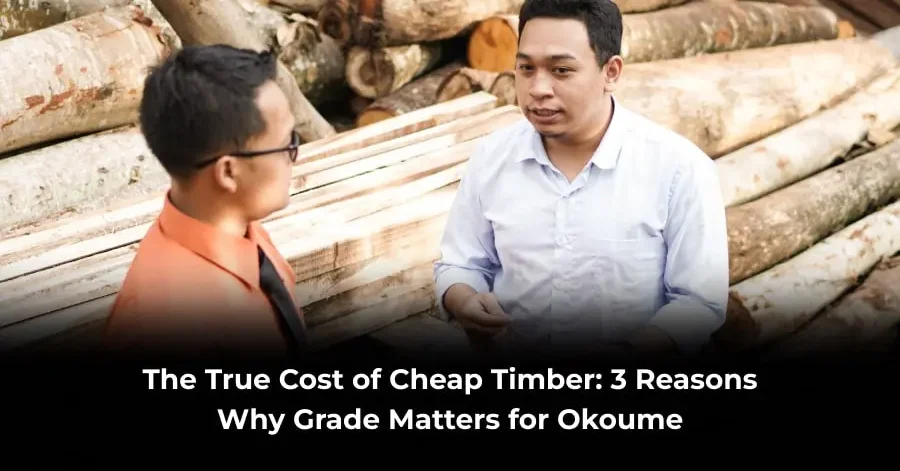You’ve found the perfect plan. Maybe it’s a graceful kayak, a sleek piece of mid-century furniture, or that built-in bookshelf that will finally make your living room feel complete. Your material of choice? Okoume timber. It’s a brilliant selection. Known for its light weight, beautiful pinkish hue, and excellent workability, this African hardwood is a favorite among boatbuilders, fine furniture makers, and discerning hobbyists.
But then you hit a crossroads. You’re browsing a woodworking supplies store, online or in-person, and you see a massive price difference between two piles of what’s supposedly the same wood. One is labeled “Premium” and carries a higher price tag. The other is simply “Okoume” and is significantly cheaper. The temptation is real. Why pay more?
As someone who has felt the sting of a project gone wrong over a few saved dollars, let me tell you: with Okoume wood, the initial price is a tiny part of the story. The true cost of cheap timber is measured in wasted hours, frustrated effort, and compromised results. The secret to unlocking the full potential of this magnificent material lies in understanding the wood grading system.
This isn’t just about aesthetics; it’s about the very soul of your project. Let’s dive into the three compelling reasons why grade matters for Okoume timber, and why skipping that education is the most expensive mistake you can make.
1. Structural Integrity: The Unseen Foundation of Your Project
When you’re building something that needs to be strong—a boat hull, a chair that will actually hold a person, or a shelving unit for your prized book collection—the internal integrity of the wood is non-negotiable. This is the first and most critical lesson any woodworking supplies store will emphasize about graded lumber.
The wood grading system for Okoume wood (and most hardwoods) is not arbitrary. It’s a rigorous visual inspection that identifies characteristics that weaken the board. Lower-grade Okoume timber can be riddled with hidden flaws:
- Knots: Especially loose or “encased” knots can pop out under stress or when planed, leaving you with a sudden, frustrating hole.
- Splits and Checks: These cracks at the end of the board or along the face can propagate further during milling and assembly, turning a full-length board into scrap.
- Wane: This is when the bark or an irregular edge is still present. It means you’re paying for wood you can’t even use, reducing your yield dramatically.
Imagine spending dozens of hours meticulously stitching and gluing a kayak frame, only to discover a critical plank has a hidden weakness that cracks under tension. The financial loss of the cheap Okoume wood is nothing compared to the loss of the hundreds of dollars in epoxy, fiberglass, and, most importantly, your invested time. High-grade Okoume timber provides predictability. You know that when you cut a joint or bend a panel, the wood will respond with consistent strength. For structural applications, the grade isn’t a suggestion; it’s a specification for safety and longevity.
2. Yield and Efficiency: The Math Behind the Board Foot
Let’s talk about a less dramatic but equally costly aspect: waste. When you buy a lower grade of Okoume timber, you are not just buying a board; you are buying a puzzle. Your job becomes figuring out how to cut around the defects to salvage usable pieces.
A board of cheap Okoume wood might be 20% cheaper per board foot than a premium one. But if you have to cut away 40% of it to avoid knots, splits, and wane, you have instantly lost money. You’ve also lost time, mental energy, and workshop space to the scrap pile.
This is where the wood grading system proves its economic value. A high-grade board from a reputable woodworking supplies store is, in essence, pre-processed for efficiency. The clear, consistent grain means you can make your cuts according to your plan, not according to the board’s flaws. Your yield—the percentage of the board you actually use in your project—skyrockets.
For the professional, time is money. Wasting an hour re-planning cuts and milling around defects is an hour lost from finishing the project. For the hobbyist, that hour is a precious slice of weekend freedom. Choosing a superior grade of Okoume timber is an investment in a smoother, more enjoyable, and ultimately more productive building process. You buy less wood to achieve the same result, and you finish your project faster.
3. Aesthetic and Finish: Where Good Becomes Great
So you’ve built a structurally sound, efficient piece. Now comes the moment of truth: the finish. This is where your project transforms from a construction into a creation. And this is where the grade of your Okoume wood makes all the difference between “handmade” and “heirloom.”
Okoume timber is prized for its fine, uniform texture and its ability to take a finish beautifully, revealing a lovely, silky luster. Lower grades sabotage this potential. A patchwork of filler to cover knots, tear-out around irregular grain, and visual distractions will forever mark your piece as amateur.
High-grade Okoume wood offers a clean, uninterrupted canvas. Whether you plan to showcase the natural wood under a clear varnish, stain it to mimic mahogany (a common and beautiful use), or paint it, the surface will be flawless. The grain will flow consistently, the color will be even, and the entire piece will have a professional, intentional look.
Think of it as the difference between painting on a rough, lumpy wall versus a smooth, primed canvas. The quality of the substrate determines the quality of the final masterpiece. When you source your materials from a specialist woodworking supplies store that understands the wood grading system, you are not just buying wood; you are buying the potential for perfection.
Also Read: How to Finish Okoume Plywood: A Step-by-Step Guide for Maximum Protection
AEW Woods: Your Partner in Quality
Understanding the importance of grade is one thing; finding a reliable source for it is another. This is where partnering with a specialist becomes crucial. Companies like AEW Woods have built their reputation on a deep understanding of materials like Okoume timber. They don’t just sell wood; they curate it.
AEW Woods and similar dedicated suppliers go to great lengths to import high-grade Okoume wood directly from responsible sources. Their expertise in the wood grading system means they can provide you with the exact quality your project demands, whether you need marine-grade plywood for a boat or clear, solid stock for fine furniture. By choosing a supplier that prioritizes quality, you are effectively outsourcing the risk. You can trust that the Okoume timber you receive will be consistent, well-documented, and worthy of your vision, saving you the hassle of sifting through piles of subpar lumber at a general woodworking supplies store.
Conclusion
The allure of cheap Okoume timber is understandable, but it is almost always a mirage. The initial savings are quickly eroded by hidden costs: compromised strength that risks your entire project, frustrating waste that eats into your budget and time, and a flawed canvas that prevents your work from achieving its true beauty.
The wood grading system is not a marketing ploy; it is a language of quality, a map that guides you to a successful outcome. By investing in a high grade of Okoume wood from a trusted source, you are not just purchasing a material. You are purchasing peace of mind, efficiency in your workflow, and the raw potential for creating something truly extraordinary. The next time you walk into a woodworking supplies store or browse online, see the price tag not as a cost, but as a direct investment in the joy of building and the pride of a project well done. Choose grade. Your future self, admiring your finished masterpiece, will thank you for it.
Frequently Asked Questions (FAQs)
Q1: I’m just building a simple indoor box. Do I really need high-grade Okoume wood?
For non-structural, utilitarian projects where appearance doesn’t matter, a lower grade can be a cost-effective choice. However, always be mindful of major structural defects like deep splits that could cause the wood to fail, even in a simple application.
Q2: How can I tell the grade of Okoume timber at my local woodworking supplies store?
Don’t be afraid to ask! A reputable dealer should be able to explain their grading (e.g., “A” grade for clear face, “B” for more knots, etc.). If they can’t, it’s a red flag. Visually, look for a high ratio of clear, knot-free wood and minimal end checks or wane.
Q3: Is all “Marine Grade” Okoume plywood the same?
No, this is a critical distinction. “Marine grade” primarily refers to the type of waterproof glue used. The veneer quality on the face and back is still governed by a wood grading system (e.g., A-A, A-B, etc.). For a beautiful finish, you still need a high face veneer grade.
Q4: Why is there such a big price gap between different grades of Okoume wood?
The price reflects the scarcity and quality. A clear, long, defect-free board is much rarer and requires more skilled labor to harvest and mill than a knotty, irregular one. You are paying for the yield, consistency, and beauty that the higher-grade Okoume timber guarantees.
Q5: Can I save money by buying a lower grade and just using wood filler?
For small pin knots, this can be acceptable. However, for larger defects, filler is often visible and can not replicate the structural integrity of solid wood. It’s a cosmetic fix that can compromise the long-term durability and professional look of your project.






